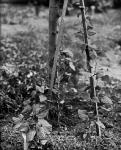Wild Yam. Dioscorea villosa L.
 OTHER COMMON NAMES—Dioscorea, colicroot, rheumatism-root, devil's bones.
OTHER COMMON NAMES—Dioscorea, colicroot, rheumatism-root, devil's bones.
HABITAT AND RANGE—Wild yam grows in moist thickets, trailing over adjacent shrubs and bushes, its range extending from Rhode Island to Minnesota, south to Florida and Texas. It is most common in the central and southern portions of the United States.
DESCRIPTION OF PLANT—This native perennial vine is similar to and belongs to the same family as the well-known cinnamon vine of the gardens-namely, the yam family (Dioscoreaceae.) It attains a length of about 15 feet, the stem smooth, the leaves heart shaped and 2 to 6 inches long by 1 to 4 inches wide.
The leaves, which are borne on long, slender stems, are thin, green, and smooth on the upper surface, paler and rather thickly hairy on the under surface. The small greenish yellow Rowers are produced from June to July, the male flowers borne in drooping clusters about 3 to 6 inches long, and the female flowers in drooping spikelike heads. The fruit, which is in the form of a dry, membranous, 3-winged, yellowish green capsule, ripens about September and remains oil the vine for some time during the winter.
Growing farther south than the species above mentioned is a variety for which the name Glabra has been suggested.
According to C. G. Lloyd, there is a variety of Dioscorea Villosa, the root of which first made its appearance among the true yam roots of commerce, and which was so different in form that it was rejected as an adulteration. The plant, however, from which the false root was derived was found upon investigation to be almost identical with the true yam, except that the leaves were perfectly smooth, lacking the hairiness on the under surface of the leaf which is characteristic of the true wild yam. The false variety also differs in its habit of growth, not growing in dense clumps like the true wild yam, but generally isolated. The root of the variety, however, is quite distinct from that of the true wild yam, being much more knotty. Lloyd states further that the hairiness or lack of hairiness on the under side of the leaf is a certain indication as to the form of the root.
Lloyd, recognizing the necessity of classifying these two yam roots of commerce, has designated the smooth-leaved variety as Dioscorea Villosa var. Glabra. (= male plants of Dioscorea villosa. -Henriette)
DESCRIPTION OF ROOTSTOCKS—The rootstock of the true wild yam runs horizontally underneath the surface of the ground. As found in commerce, it consists of very hard pieces, 6 inches and sometimes 2 feet in length, but only about one-fourth or one-half of an inch in diameter, twisted, covered with a thin, brown bark, whitish within and showing stem scars almost an inch apart on the tipper surface, small protuberances on the sides, and numerous rather wiry rootlets on the lower surface.
The false wild yam, on the other hand, has a much heavier, rough, knotty rootstock, with thick branches from 1 inch to 3 inches long, the upper surface covered with crowed stem scars and the lower side furnished with stout, wiry rootlets. Within it is similar to the true yam root.
COLLECTION, PRICES AND USES—The roots are generally collected in autumn, and bring from 2 ½ to 4 cents a pound. Wild Yam is said to possess expectorant properties and to promote perspiration, and in large doses providing emetic. It has been employed in bilious colic, and by the negroes in the South in the treatment of muscular rheumatism.
Ginseng and Other Medicinal Plants, 1936, was written by A. R. Harding.

